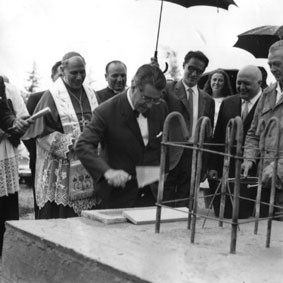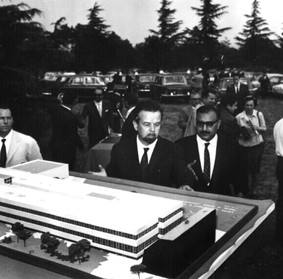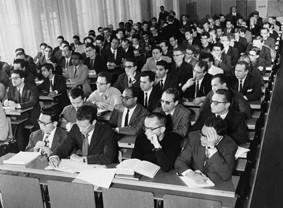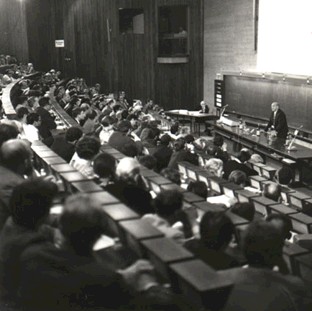Personal tools
News from ICTP 108 - Features - ICTP in the 1960s

The 1960s, ICTP's 'startup' decade, was a tumultuous time, marked by uncertainty and success. Paolo Budinich explains.
ICTP in the 1960s:
Foundations of Success
On 18 June 1964, Carlo Arnaudi, Italy's Minister of Scientific Research, and Sigvard Eklund, Director General of the International Atomic Energy Agency (IAEA), laid the foundation stone for what would become ICTP's main building. The ceremony symbolised the creation of the Centre, fulfilling the vision first put forth by Abdus Salam four years before.

18 June 1964 Minister Carlo Arnaudi lays cornerstone of Main Building

Paolo Budinich and Abdus Salam examine model of new building
The Main Building at Miramare, however, would take four years
to complete, not opening its doors until 1968. Thanks to the generosity
of the local Italian authorities, the Centre was given temporary
space in a five-story building on Piazza Oberdan, located in the
heart of the Trieste.
The building on Piazza Oberdan was not fully renovated in time
for the Centre's first major activity--the International Seminar
on Plasma Physics held in October 1964. As a result, the seminar
took place in the conference hall of the Jolly Hotel, located
less than a kilometre from Piazza Oberdan.
At the time, there was the even more compelling challenge of assembling
a capable administrative staff for a fledgling organisation with
an uncertain future.
Many of the administrative posts that remain in place to this
day were created during the Centre's first years of operation.
Indeed, by late 1964, ICTP's scientific and support staff included
a director (Abdus Salam), deputy director, scientific information
officer, administrator, librarian, secretaries, clerks, and technical
staff.
Two major distinctions, however, highlight the difference between
now and then.
Now, the staff totals 120; then, 25.
Now, long-term staff members are all employees of the UN system.
Then, staff were locally recruited under the terms of the 'seat
agreement' between the IAEA and the Italian government.
Even more importantly, because IAEA approved the creation of the
Centre on a 'provisional' basis--subject to a comprehensive review
after four years--no one was sure if ICTP would continue operating
beyond its trial run. Indeed some IAEA member states that had
supported the creation of the Centre suggested that ICTP, if successful,
should eventually be moved from Italy to a developing country.
During the Centre's early years, ICTP's budget was also in question.
The Italian government had authorised more than US$275,000 a year
for the first four years of ICTP's operations. Moreover, the land
and structures that were part of the Centre complex were valued
at more than US$2.5 million.
IAEA, in turn, initially budgeted US$55,000 annually for the Centre
(rising to US$150,000 in 1967). This represented a generous contribution
given the Agency's modest budget yet broad-ranging responsibilities
that reached far beyond scientific research and training to include
efforts to promote peaceful applications of nuclear energy and
the creation of inspection teams to curb nuclear proliferation.
However, those who examined the Centre's mandate--including a
Consultative Committee of Experts appointed by IAEA's director
general and the Centre's own Scientific Council--all agreed that
ICTP would need an annual budget between US$500,000 and US$750,000
to fulfil its mandate.
As a result, the Centre in the 1960s was continually searching
for money to bring its resources closer in line with its vision.
The Ford Foundation, which awarded ICTP a four-year US$200,000
grant, helped to make up the difference. Nevertheless, the funding
was not permanent and there was no guarantee that it would continue.
Partially due to its provisional status and budget uncertainties,
the Centre did not have a permanent research staff. Instead it
relied on visiting and guest scientists and professors of the
University of Trieste (who acted as consultants) to meet its research
and training needs.
Like many working for ICTP's administrative staff, scientists
at the Centre actually belonged to other institutions, coming
to the Centre during periods when university classes were not
in session or at a time when they were on sabbatical leave.
Visiting professors during these early years included A.O. Barut,
University of Colorado at Boulder, and Christian Fronsdal, University
of California at Los Angeles, USA. During ICTP's first academic
year, 1964-1965, each stayed for 10 months to organise and participate
in training activities for younger scientists.
Similarly, Marshall N. Rosenbluth, University of California, San
Diego, USA, and Roald Z. Sagdeev, head of the Plasma Physics Laboratory,
Institute of Nuclear Physics, Novosibirsk, USSR, came to Trieste
to help launch the plasma physics group. Rosenbluth's and Sagdeev's
partnership--indeed friendship--helped to make ICTP one of the
few places in the world where scientists from the East and West
could work side-by-side during the Cold War.
In addition, such prominent institutions as Princeton University
in the United States, Imperial College in the United Kingdom,
CERN (European Organization for Nuclear Research) in Geneva, Switzerland,
and the Joint Institute for Nuclear Research, Dubna, USSR, allowed
their staff scientists to come to the Centre for several months
each year, providing a steady stream of world class scientists.
Despite all of the vagaries and unknowns, ICTP flourished during
the first decade of its existence thanks to the drive of Abdus
Salam and the enthusiastic support of the word scientific community.
The efforts laid a foundation for success that quickly earned
the Centre international acclaim.
ICTP's first scientific activity was a four-week International
Seminar on Plasma Physics, held in October 1964, which attracted
such eminent scientists as Boris B. Kadomtsev, USSR Academy of
Sciences' Nuclear Energy Institute, and W.B. Thompson, Clarendon
Laboratory, UK. The Centre's second scientific activity, a two-month
Seminar on High Energy Physics and Elementary Particles, which
took place in May and June 1965, included future Nobel Prize winners
Murray Gell-Mann, Sheldon Glashow and Julian Schwinger.

Seminar on High Energy Physics and Elementary Particles, June 1965
And then there was the star-studded Symposium on Contemporary
Physics held from 7 to 29 June 1968--an event that put ICTP on
the global scientific map serving as the 'symbolic' foundation
stone of its scientific activities.

Werner Heisenberg lectures during the Symposium on Contemporary Physics, June 1968. Paul A.M. Dirac (in background) chairs session
The symposium, which was attended by nearly 300 scientists from
some 40 countries, brought 21 current and future Nobel Prize winners
to Trieste. Among the scientific luminaries in attendance were
Hans A. Bethe, Francis H.C. Crick, Paul A.M. Dirac, Werner Heisenberg
and Eugene P. Wigner. The gathering marked the arrival of ICTP
as a world class research centre dedicated to cutting-edge issues
in physics and with the capacity to attract the world's most talented
scientists. The symposium also indicated the Centre's emergence
as a prominent crossroads for scientific exchange.
Besides the workshops and seminars, there were three extended
courses (two in nuclear physics and one in condensed matter physics),
each with some 100 participants and each lasting from 10 to 12
weeks. The courses, which included introductory lectures during
the first week and examinations of the most recent advances in
the field for the remainder of the time, attracted young physicists
from developing countries and developed countries alike. The latter
were not financially supported by ICTP but were eager to come
nevertheless.
Building on the success of these noteworthy activities, by the
end of the 1960s, ICTP had attracted more than 1500 scientists
from 55 countries.
At the same time that the Centre was earning a well-deserved reputation
for research and training excellence, it was also launching what
would become its flagship programme: the Associateship Scheme,
which enabled scientists from the developing world to visit the
Centre for extended periods three times over a three-year period
(later extended to six years).
The ultimate goal was to allow scientists from the South to remain
at home yet to be fully engaged in cutting-edge science. Among
the Centre's first Associates were Juan Jose Giambiagi (Argentina),
Riazuddin (Pakistan), Igor Saavedra (Chile), and Daniel A. Akyeampong
(Ghana), each of whom went on to have distinguished careers in
science and science administration in their home countries. Over
the years ICTP has selected more than 2000 Associates.
In less than a decade the Centre had indeed laid the foundation
stones--both symbolically and concretely--for its success. As
a result, ICTP ended the 1960s as an institution proud of its
rapid progress and cautiously optimistic about the prospects for
growth and maturity in the 1970s.
Paolo Budinich
ICTP Deputy Director, 1964-1978